Roland Special has become known as any semi-automatic pistol that has been highly customized by its owner. We are not just talking about dropping in an aftermarket trigger or swapping out sights. A Roland Special build is a reflection of the owner’s needs and personality with aftermarket slides, barrels, triggers, firing pins, optics, magazine wells, custom grip stippling, slide stops, magazine releases, and a whole lot more. There really is no limitation on the amount of customization and aftermarket parts, other than the owner’s bankroll and how much they are willing to spend on a self-customized pistol.
The idea of the Roland Special started as a joke by putting a compensator on a concealed-carry Glock G19 equipped with a SureFire X300U tactical light. The idea to comp a G19 came from a member on the PrimaryandSecondary.com forum back in 2015, and that mod morphed into the Roland Special. Today, the Roland Special has spawned a following of kitchen-table gunsmiths creating customized and personalized Glocks, as well as S&W M&Ps, FN 509s, H&Ks, CZs, and others. Just go to Instagram or Pinterest and search “roland special” to see a massive amount of custom pistols, with some going more for the cool factor rather than performance and usability, in our opinion.
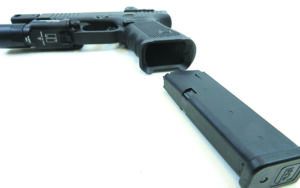
For this match up, we built a traditional Roland Special almost exactly like the original Glock G19 circa 2015, but like kitchen-table gunsmiths before us, we tweaked the build. We also slightly modified a Stoeger SRT-9 Combat with an optic and compensator. Our third pistol is the Springfield Armory Hellcat RDP, which is a factory-made Roland Special version of Springfield’s Hellcat. All of these pistols use a striker-fire system and DAO trigger with a flat face, along with a polymer frame. Other similarities between these pistols is a slide-mounted red-dot optic — green dot in the case of the Stoeger — and a compensator. We chose these three levels of Rolandism to illustrate how Gun Tests readers can adjust their sights on their own handguns to modify them as little, or as much, as they want, according to their needs and their wallets.
The idea behind a compensated pistol is to reduce muzzle flip. We fired all three pistols with and without their compensators and found there is a reduction in flip when using a compensator. The ports in the compensator and the extra weight help to stifle muzzle rise. The benefit of a red/green dot optic is more precise aiming and faster target acquisition. With a red-dot sight, all you need to do is place the dot on the target to aim, there is no front sight/rear sight alignment required.
How We Tested
We first tested for accuracy at 15 yards, where both the Hellcat and G19 gave us one ragged hole depending on the ammo we used and our concentration. We also tested at 15 yards for speed and reloads. The compact Glock and full-size Stoeger were easiest to manipulate. The subcompact Hellcat RDP was smaller, and we had to modify our reloading technique to ensure the magazine was fully seated and we didn’t pinch our fingers.
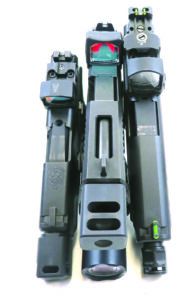
Our 9mm Luger ammunition consisted of three loads, two training loads with full-metal-jacket ammo and one defense load with hollow points. Remington Golden Saber Bonded, the defense load, uses a 147-grain BJHP bullet. For training ammo, we used an Armscor brand with a 124-grain FMJ and Defender remanufactured ammo with a 115-grain FMJ.
Because you, the shooter, have customized the pistol, you make it yours by adapting the gun to your shooting style. The thing with a Roland Special is you can easily swap out parts if you don’t like how they perform. One thing to remember when doing a custom build, not all parts may work perfectly together, meaning you may initially experience some failures to feed or eject until parts have broken in. This happened with our G19 build, but we were able to quickly work the bugs out and get it to run consistently. Here’s what else we found with these custom and factory builds.
Gun Tests Grade: A
$2295
We started this project with the help of a gun owner who wanted to build his own Roland Special. The base gun cost $700, so the upgrades are obviously multiples of the retail price of a Glock 19. In our opinion, the Roland Special has four parts that are necessary for a true rendition of the style. The obvious is a Glock 19. Our G19 Gen4 came with three polymer 15-round magazines and four modular rear grip straps. We next added a KKM Precision G19B1C match barrel and comp ($305; KKMPrecision.com) and a Trijicon RM06 RMR Model RM06-C-700672 ($499; OpticsPlanet.com), with a 3.25-minute-of-angle red dot. And, for illumination, we chose a SureFire X300U-A light ($296; PrimaryArms.com). Any build with these components we consider to be a “true” Roland Special.
| Action | Semi-auto, short recoil-operated locked breech, striker fired; Lone Wolf AlphaWolf stainless extractor |
| Trigger | Overwatch TAC, Double Action Only |
| Overall Length | 8.12 in. |
| Overall Height | 6.62 in. |
| Maximum Width | 1.43 in. |
| Weight Unloaded | 37.30 oz. |
| Weight Loaded | 43.75 oz. |
| Barrel | 4.00 in.; KKM Precision G19B1C match barrel and comp |
| Capacity | 15 |
| Slide | Brownells Glock 19 Gen4 |
| Slide Retraction Effort | 15.0 lbs. |
| Frame | Black, polymer; Strike Industries Model SI-G4-MAGWELL |
| Frame Front Strap Height | 2.34 in. |
| Frame Back Strap Height | 3.14 in. |
| Grip | Textured polymer, 4 inserts |
| Grip Thickness (max) | 1.20 in. |
| Grip Circumference (max) | 5.75 in. |
| Sights | Ameriglo GL-429 |
| Optics | Optics-ready slide; Trijicon RM06 RMR |
| Trigger Pull Weight | 5.28 lbs. |
| Trigger Span | 2.84 in. |
| Magazines | 2; polymer |
| Magwell | Strike Industries SI-G4-MAGWEL |
| Manual | Trigger, drop safety |
| Warranty | 1 year |
| Telephone | (770) 432-1202 |
| Website | US.Glock.com |
| Made In | USA |
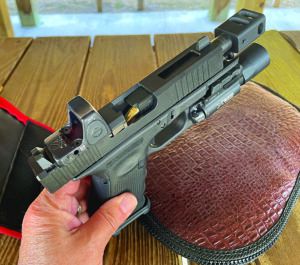
We used the SureFire on the Glock as well as the Stoeger. It has an all-aluminum body, so it is tough. In fact, this weapon light is used by military and LE personnel, so it is street and battlefield tested. It pushes out a 1,000-lumens LED beam that makes darkness go away at close to medium distance and has peripheral illumination so you can maintain situational awareness. The on/off switch is easy to access and operates with the trigger finger for both left- and right-hand shooters or the thumb of the supporting hand. We like that you can activate the light without altering your grip. It’s powered by two 123 lithium batteries that can be found at nearly any store that sells batteries. It has a 1.25-hour run time. The Rail-Lock system allows rapid attachment to and removal from pistol rails. The downside of the U light is it is long and heavy, but the extra 4 ounces it adds at the muzzle end also helps flatten muzzle flip.
The slide was a Brownells Glock 19 Gen4 unit ($240; Brownells.com 078-000-459), which was milled with forward serrations and a mount for RMR. Then we added an Ameriglo tall flat-black optic-compatible sight set GL-429 ($60; Ameriglo.com) that co-witnessed with the Trijicon RMR. For the slide internals, we used stock OEM Glock except for the Lone Wolf Distributors AlphaWolf stainless extractor, Model AW-EXTRACTOR ($50; LoneWolfDist.com). The shiny stainless part added a bit of bling to the matte-black pistol. For a trigger, we used an Overwatch TAC trigger ($125; OverwatchPrecision.com), which reduces overtravel and doesn’t feel gritty. We stuck with the Glock OEM connector and also kept the OEM grip texture. Last, we added a Strike Industries Magwell Model SI-G4-MAGWELL ($20; StrikeIndustries.com). The cost of aftermarket parts was $1595, bringing the grand total for the build with the Glock to $2295.
After we got over the sticker shock, we ran the gun to see which of the add-ons were worth it.
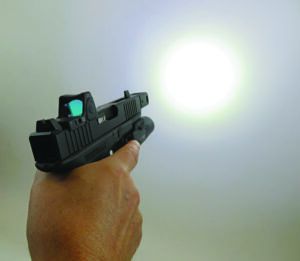
Firing the G19 Gen4 without the comp gave us that familiar snap of the G19. Very controllable, but there’s some muzzle flip. Adding the comp, the pistol shot much flatter, with follow-up shots that were quicker. The KKM comp has four ports, one at 3 o’clock, one at 9 o’clock, and two at 12 o’clock. The comp looks like an extension to the slide, with a blocky shape. We felt this comp offers more performance than aesthetics, and that is fine by us. The accuracy and usability were sublime. Our best group was with the Remington Golden Saber rounds that measured 0.8 inch for five rounds at 15 yards. The KKM barrel gave us groups that ranged from 0.85 inch to 1.71 inches, depending on the load. Accuracy was much better than a stock Glock barrel.
The Brownells slide has a slot cut out of the top of the slide so there is less slide mass than the typical G19 slide. The balance was nice, and the pistol cycled smoothly. We liked the forward serrations for press checks, and the Trijicon dropped into the cut on top for easy installation. The Ameriglo steel sights co-witnessed with the Trijicon, which we liked. Early on we had a few FTF (Failure To Feed) jams, but we lubed the gun, and it ran non-stop afterward. We also had to tighten the front sight; we omitted the LocTite just to see if it would rattle loose under recoil, and it did. We also had to tighten the comp after use.

The Trijicon RM06 RMR is a battle- and street-tested accessory that features a forged aluminum housing that is rugged and shaped so it can be used to rack the slide, which we did numerous times during testing. The 3.25-moa red dot is a good size for close-to-medium aiming. The sight has an automatic mode that adjusts the brightness of the aiming dot to environmental lighting conditions, or you can adjust brightness via two buttons, one on each side of the housing. The unit uses one commonly found CR2032 battery that juices the sight for up to four years. You need to remove the sight from the slide to replace the battery, and we found no change in zero when doing this in the past with other Trijicon RMR sights. The windage and elevation are clearly marked with arrows indicating direction. You can use the rim of a 9mm case to make adjustments. In our opinion, this is a first-class red dot designed for hard use.
When we started to throw lead downrange fast and do reloads, the magazines were not falling free. The Strike Industries magwell didn’t allow for the empty magazine to fall free. We had to strip them out by hand. Notches on the sides of the magwell allowed us to easily strip the magazine out. We noticed the edge of the magwell was touching the magazine, so we advocated the owner take a file to the magwell before he deep-sixed it. We liked how the magwell provide a small shelf for our small finger when gripping.
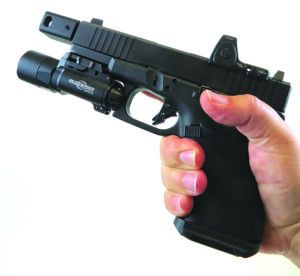
The Overwatch Precision TAC trigger has a small indexing hook at the tip to ensure consistent trigger-finger placement, and the broad, flat face of the trigger allows a uniquely self-correcting straight-rearward press, like most flat triggers. It also resets faster than the OEM Glock trigger. Even though the trigger press still felt like an OEM Glock trigger, we liked the TAC trigger and think it is well suited for EDC and defense work. Our accuracy data confirms we were able to use the trigger effectively.
Our Team Said: The G19 Gen4 greatly benefited in performance with the slide, barrel/comp set up and optics, but at a cost. We liked the balance and accuracy as well as the ability to get back on target fast. Would we add anything else? We would have liked the magazine release to extend more from the grip. The owner of the gun said he may look into adding an oversized aftermarket magazine release.
9mm Luger Range Data (15 Yards)
To collect accuracy data, we fired five-shot groups from a bench using a rest and open sights. We recorded velocities using a ProChrono digital chronograph set 15 feet from the muzzle.| Defender Remanufactured 115-grain FMJ | Glock Gen4 Model 19 | Stoeger STRS-9 Combat | Springfield Armory Hellcat RDP |
| Average Velocity | 1135 fps | 1151 fps | 1118 fps |
| Muzzle Energy | 329 ft.-lbs. | 338 ft.-lbs. | 319 ft.-lbs. |
| Smallest Group | 1.00 in. | 1.07 in. | 1.33 in. |
| Average Group | 1.71 in. | 1.21 in. | 1.59 in. |
| Armscor 124-grain FMJ | Glock Gen4 Model 19 | Stoeger STRS-9 Combat | Springfield Armory Hellcat RDP |
| Average Velocity | 1048 fps | 1039 fps | 1079 fps |
| Muzzle Energy | 302 ft.-lbs. | 297 ft.-lbs. | 321 ft.-lbs. |
| Smallest Group | 1.02 in. | 2.05 in. | 0.51 in. |
| Average Group | 1.11 in. | 2.24 in. | 0.73 in. |
| Remington Golden Saber 147-grain BJHP | Glock Gen4 Model 19 | Stoeger STRS-9 Combat | Springfield Armory Hellcat RDP |
| Average Velocity | 1042 fps | 1055 fps | 973 fps |
| Muzzle Energy | 354 ft.-lbs. | 363 ft.-lbs. | 309 ft.-lbs. |
| Smallest Group | 0.80 in. | 2.11 in. | 1.21 in. |
| Average Group | 0.85 in. | 2.35 in. | 1.60 in. |































I’m sorry but is this really something an average gun owner would be interested in? If I wanted to spend $2300 on a pistol it would not be a Glock.
Can you be more specific about the content of your article? After reading it, I still have some doubts. Hope you can help me.